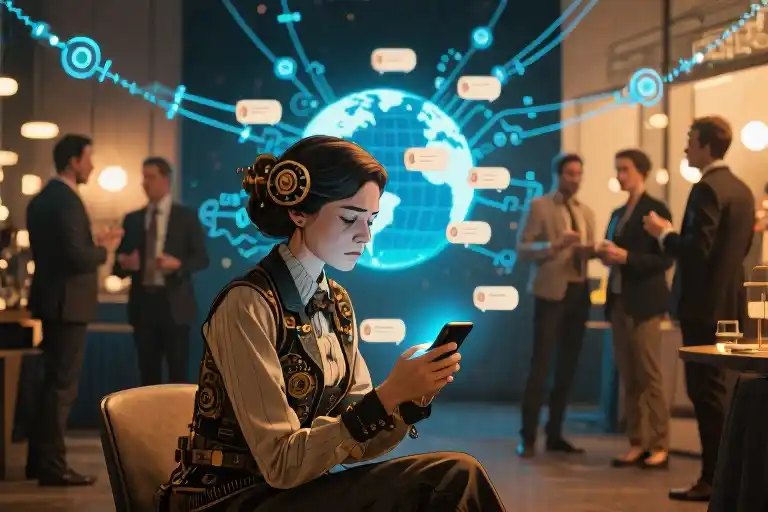The morning edition of the New-York Tribune on August 17, 1858 carried extraordinary news. As crowds gathered at newspaper offices across Manhattan, the freshly printed pages announced the completion of the transatlantic telegraph cable – a technological marvel that promised to ‘annihilate time and space.’ Charles Briggs and Augustus Maverick’s euphoric prose captured the collective imagination: “The whole earth will be belted with the electric current, palpitating with human thoughts and emotions… This binds together by a vital cord all the nations of the earth.”
Fast forward 166 years to a Silicon Valley conference hall where similar proclamations echo. A keynote speaker gestures toward holographic projections of AI avatars conversing in real-time across language barriers. “This isn’t just machine translation,” the presenter declares, “it’s the dawn of a new cognitive layer for humanity – a digital lingua franca that will finally realize the dream of universal understanding.”
This persistent pattern – what historian David Nye calls “technological sublime” – reveals our enduring tendency to imbue new inventions with almost messianic powers. From the 19th century’s “vital cord” of telegraph wires to today’s neural networks, each breakthrough carries inflated expectations of solving humanity’s oldest divisions. The central paradox emerges: why do these visions of technological unity consistently outpace reality?
Three fundamental gaps explain this chronic optimism gap. First, the material constraints that early enthusiasts overlooked – the 1858 cable failed within weeks, just as today’s AI systems struggle with cultural nuance. Second, the human factor – no technology automatically erases prejudice, as evidenced by hate speech proliferating through the very platforms designed to connect us. Finally, the commercial realities – AT&T’s “great voice in the ether” became monetized long-distance calls, much like social media’s promise of global village devolved into attention economies.
Yet these historical parallels hold valuable lessons for our current crossroads. When John J. Carty envisioned telephones creating “one brotherhood,” he couldn’t foresee how communication technologies actually amplify both connection and fragmentation simultaneously. As we stand at the threshold of brain-computer interfaces and quantum networks, the telegraph’s unfinished revolution reminds us: true understanding requires more than faster pipes – it demands conscious design of the ideas flowing through them.
The pages that follow trace this journey from Victorian optimism to digital-age reckoning. We’ll examine how 19th century engineers became accidental poets of human unity, why their visions remain partially fulfilled, and what their experiences teach us about evaluating today’s grand claims for AI and the metaverse. Because ultimately, the most useful technology might be historical perspective itself – the ability to recognize familiar patterns in our newest dreams of connection.
The Communication Messiahs of the Gilded Age
As the 19th century unfolded its technological marvels, two revolutionary inventions captured the collective imagination with almost religious fervor. The telegraph and telephone weren’t merely tools—they became vessels carrying humanity’s deepest hopes for connection and understanding. What began as scientific breakthroughs quickly transformed into cultural prophecies, revealing how quickly we imbue new technologies with world-changing potential.
Colonial Wires and Imperial Dreams
The telegraph’s rapid expansion during the 1850s coincided perfectly with the British Empire’s need for faster communication across its vast territories. What Briggs and Maverick celebrated as a ‘transcendental’ force served very practical imperial purposes—governing colonies, coordinating troops, and managing trade routes became exponentially easier when messages could cross oceans in hours rather than weeks. The same cables that ‘belted the earth with electric current’ also tightened the grip of colonial powers, creating an early example of how communication technologies amplify existing power structures.
This dual nature manifested clearly in the 1858 transatlantic cable project, where technological ambition walked hand-in-hand with commercial and political interests. While newspapers rhapsodized about the telegraph creating ‘a vital cord’ between nations, businessmen calculated faster commodity prices, and generals planned more efficient troop deployments. The infrastructure that promised to eliminate ‘old prejudices’ first served to consolidate imperial control, demonstrating how technologies acquire different meanings for different groups.
The Telephone’s Spiritual Promise
Three decades later, AT&T engineer John J. Carty’s vision for the telephone carried forward this tradition of technological prophecy, but with an even more pronounced spiritual dimension. His prediction of a ‘great voice coming out of the ether’ consciously echoed biblical language, framing the telephone not just as an invention but as a divine instrument for achieving ‘peace on earth.’ This wasn’t engineering jargon—it was technological evangelism at its most poetic.
The religious metaphors surrounding early telephone development reveal how deeply Victorians associated technological progress with moral advancement. When Bell demonstrated his invention at the 1876 Philadelphia World’s Fair, commentators described the apparatus with reverence typically reserved for sacred objects. The language of ‘ether’—that mysterious invisible medium once thought to fill the universe—became a bridge between scientific discovery and spiritual yearning.
Decoding the Messiah Complex
Analyzing these historical texts reveals three consistent markers of what we might call ‘technological messianism’:
- Universalism: Claims that the technology will inevitably reach all humanity
- Moral Transformation: Promises that the tool will fundamentally improve human nature
- Inevitable Adoption: Assumptions that everyone will naturally embrace the invention
Both the telegraph and telephone prophecies exhibit this triad in full force. The original 1858 telegraph passage contains no less than four assertions about global adoption (‘all nations of the earth’ appears twice), while Carty’s telephone vision skips straight to assuming a universal language. These documents show no awareness that technologies require deliberate social choices about access, design priorities, and governance—they operate on what we now recognize as a form of technological determinism.
What makes these Victorian-era predictions particularly fascinating is their blend of accurate foresight and profound naivety. The telegraph did indeed ‘belt the earth,’ just as the telephone became globally ubiquitous—but neither produced the automatic brotherhood their proponents imagined. This gap between technical capability and social outcome forms the central paradox we still grapple with today, as every generation seems destined to rediscover that connecting devices proves easier than connecting hearts and minds.
The Unfinished Connectivity Revolution
The Physical Network: Global Coverage and Digital Divides
The 19th century vision of a perfectly connected world through telegraph wires now manifests in our constellation of fiber-optic cables and satellite networks. Yet beneath the impressive 67% global internet penetration rate (ITU, 2023) lies a stark reality: nearly 2.7 billion people remain offline, concentrated in Sub-Saharan Africa and Southern Asia. This digital divide mirrors the early telegraph era when colonial powers prioritized connections between London and Bombay over local African networks.
Modern infrastructure maps reveal an uncomfortable truth – the “vital cord” Briggs envisioned now forms an uneven web. Undersea cables cluster along historical trade routes, with South America and Africa having significantly fewer landing points. The Starlink project, while revolutionary, currently serves mostly affluent users at $120/month, recreating the 1850s pattern where telegraph services primarily benefited merchants and colonial administrators.
The Cultural Paradox: Social Media’s Double-Edged Sword
Social platforms achieved what Carty dreamed – enabling real-time conversations across continents. However, the 2023 Pew Research study shows 64% of users feel these tools simultaneously connect and divide. The same algorithms that help diaspora communities maintain ties also create ideological echo chambers, with recommendation systems increasing political polarization by 37% according to MIT studies.
Platforms like Facebook initially promised to “bring the world closer together,” yet language barriers and algorithmic biases often reinforce cultural silos. A striking example: during the 2022 Ukraine crisis, Russian and Ukrainian users saw completely different information ecosystems despite technically sharing the same platform – a far cry from the “common understanding” AT&T predicted.
The Linguistic Utopia: From AT&T to AI Translators
Machine translation breakthroughs like DeepL and Google’s AI tools have made remarkable progress toward Carty’s “common language” vision. Yet UNESCO’s 2023 report warns that 40% of languages lack any digital presence, risking permanent exclusion. The dominance of English (55% of web content) creates a new form of linguistic inequality, where non-English speakers must constantly code-switch in digital spaces.
Recent advances in real-time translation earbuds demonstrate both the promise and limitations. While they enable basic cross-language conversations, nuances of humor, poetry, and cultural references often get lost – the very elements that build true understanding. The dream of technology creating spontaneous “human brotherhood” stumbles when Somali proverbs automatically translate to corporate-friendly English idioms.
The Connectivity Paradox Resolved
Three core lessons emerge from examining these unfinished revolutions:
- Physical access ≠ meaningful participation: Just as 19th century telegraph stations stood locked to local populations, today’s digital inclusion requires addressing affordability, literacy, and cultural relevance
- Connection tools amplify existing dynamics: Social platforms mirror societal fractures rather than heal them, requiring conscious design interventions
- Linguistic equity demands intentionality: Truly universal communication needs more than technical solutions – it requires preserving linguistic diversity while building bridges
The original visionaries weren’t wrong about technology’s connective potential, but they underestimated how deeply social systems shape technological outcomes. As we build the next generation of connective technologies – from brain-computer interfaces to quantum networks – these historical insights become our most valuable design compass.
Letters from the Past: A Historical Memo for the Algorithmic Age
The Recurring Trap of Technological Optimism
History has a peculiar way of repeating itself, especially when it comes to our collective enthusiasm for new technologies. As we stand at the threshold of what many call the “AI revolution,” the passionate proclamations from 19th century telegraph and telephone pioneers echo with striking familiarity in today’s tech conferences. This cyclical pattern of technological optimism reveals five distinct characteristics that persist across centuries:
- The Messiah Complex: Like Briggs and Maverick’s description of telegraph as “transcendentally the greatest” achievement, modern AI is frequently framed as humanity’s ultimate problem-solver. The language shifts from “electric current” to “neural networks,” but the salvational tone remains identical.
- Universal Brotherhood Fantasy: John J. Carty’s vision of telephones creating world peace through a “common language” mirrors exactly today’s claims about social media and AI breaking down cultural barriers. Yet both eras overlook how technologies can equally reinforce existing power structures.
- Infrastructure Mysticism: There’s always a magical belief in the technology’s physical network – whether it’s 1858’s “vital cord” of telegraph wires or today’s undersea fiber optic cables. We romanticize the hardware while ignoring who controls these channels.
- Historical Amnesia: Each generation behaves as if their technological challenges are unprecedented. The same debates about privacy (telegraph operators reading messages vs. data mining), job displacement (operators vs. drivers), and cultural homogenization occurred with earlier communication revolutions.
- Solutionism Bias: The persistent belief that connection equals understanding. As one 19th century observer noted: “The telegraph makes neighbors of nations,” neglecting that neighbors often quarrel most intensely.
Power Lines: How Infrastructure Shapes Society
The submerged cables carrying our digital traffic today continue the legacy of those first telegraph wires – they’re not neutral pipes but political instruments. Consider:
- Colonial Continuity: 94% of internet traffic between Asia and Europe still flows through cables owned by former colonial powers, replicating 19th century communication hierarchies
- The Language Paradox: While AT&T dreamed of a universal language, today 53% of web content is in English while only 5% of the world speaks it natively
- Access As Power: Facebook’s Free Basics program, offering limited internet access to developing nations, eerily parallels 19th century arguments about “civilizing” through technology
Stress-Testing Modern Prophecies
Let’s apply historical scrutiny to today’s most ambitious claims:
Metaverse Manifestos: When tech CEOs promise virtual worlds will “transcend physical limitations,” they’re using the same rhetorical patterns as 1858’s “palpitating with human thoughts” telegraph promises. History suggests:
- Virtual spaces will likely amplify rather than eliminate human biases
- “Borderless” environments tend to create new forms of digital territorialism
- The tech will serve existing power structures more than disrupt them
AI Utopias: The belief that artificial intelligence will create universal understanding faces the same hurdles as the telephone’s “great voice” prophecy:
- Machine translation progresses, but cultural contexts remain untranslatable
- Algorithmic systems inherit the prejudices of their training data
- The “common language” often means conforming to dominant paradigms
A Practical Guide for Tech Realists
For developers and policymakers navigating today’s technological landscape, these historical lessons translate into actionable insights:
- Follow the Infrastructure – Always ask: Who owns the pipes? Who maintains the servers? Physical networks shape digital possibilities
- Beware of Universalist Claims – Technologies that promise to “unite humanity” often standardize it instead
- Study the Gaps – Look at who’s excluded from the technological vision (in 1880, it was rural populations; today, it’s the digitally illiterate)
- Expect Paradoxes – Connection enables both understanding and conflict; this isn’t a bug but a feature of human communication
- Preserve Alternatives – Just as we now value local languages threatened by globalization, we’ll regret losing non-algorithmic decision-making modes
As we compose our own technological prophecies today, we might imagine receiving letters from those 19th century optimists. Their faded ink would likely contain both warnings and encouragement: technology does transform society, but never in the straightforward ways we anticipate. The most valuable lesson from the telegraph era may be this – the greatest innovations aren’t the technologies themselves, but the wisdom we develop in using them.
Epilogue: Echoes Across Centuries
A Dialogue of Declarations
Side by side, the prophecies of 1858 and 2024 hum with eerie resonance. The telegraph’s promised “vital cord” now materializes as fiber-optic cables snaking across ocean floors, while AT&T’s “great voice from the ether” manifests in Siri’s algorithmic whisper. Yet between these technological bookends lies a sobering truth: every generation’s utopian vision carries its own blind spots.
The Unanswered Question
Three historical patterns emerge when examining communication technology prophecies:
- The Infrastructure Fallacy: Assuming physical connectivity guarantees cultural connection (telegraph cables → social media algorithms)
- The Neutrality Myth: Overlooking how technologies absorb societal biases (colonial telegraph networks → AI training data inequities)
- The Language Paradox: Predicting unification while accelerating linguistic hierarchies (19th-century English cable dominance → 21st-century AI language model skews)
Your Prophecy Toolkit
Before embracing the next “world-changing” technology, consider this five-point assessment:
| Historical Lens | Modern Application |
|---|---|
| Physical Reach (Who gets access first?) | Map infrastructure rollout patterns |
| Cultural Carriers (Whose values are embedded?) | Audit training datasets and development teams |
| Language Layers (Which voices are amplified?) | Analyze default language settings and translation accuracy |
| Power Structures (Who controls the network?) | Trace ownership and governance models |
| Unintended Effects (What disruptions emerge?) | Study secondary impacts like job displacement or mental health |
Final Reflection
The telegraph poets and telephone prophets weren’t wrong—just incomplete. Their visions live on in every satellite launch and neural network, reminding us that technological potential grows not from the tools themselves, but from our willingness to confront their complexities. As you encounter the next grand proclamation about AI or the metaverse, ask yourself: What would Charles Briggs have missed if he’d imagined the internet? What are we missing now?





